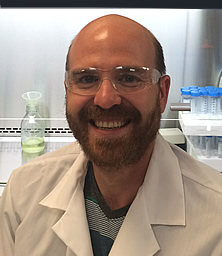 Justin Hadar,
Justin Hadar, Senior Scientist
3DCellMaker
A blog dedicated to addressing technical questions relating to 3DCellMaker.
Index
Select a topic to hide all other entries.
The most recent item is at the top.
3D Cell Culture Exhibits Clear Advantages in Evaluating Drug Sensitivity and Resistance Compared to 2D Monolayer.
Tuesday, August 23, 2016, 9:06 AM ET
3DCellMaker (www.3dcellmaker.com)
is a product from PolySciTech division of Akina, Inc. that allows for 3D growth
of cells.
Recently researchers using HER2-positive breast cancer
cell lines (BT474, HCC1954, EFM192A) displayed increased resistance to both HER targeted and classical chemotherapeutics. They also showed that protein expression involved in cell survival and transporters associated with drug resistance were increased in 3D cultures as compared to 2D monolayer cultures. This research is important to the development of better therapies for drug resistant cancer lines. Read more here: Breslin, Susan, and Lorraine O'Driscoll. "The relevance of using 3D cell cultures, in addition to 2D monolayer cultures, when evaluating breast cancer drug sensitivity and resistance." Oncotarget 7, no. 29 (2016): 45745-45756. www.tara.tcd.ie/bitstream/handle/2262/76500/Breslin%20%26%20ODriscoll_Oncotarget-2016.pdf?sequence=1&isAllowed=y
Summary:
"Solid tumours naturally grow in 3D wherein the spatial arrangement of cells
affects how they interact with each other. This suggests that 3D cell culture may
mimic the natural in vivo setting better than traditional monolayer (2D) cell culture,
where cells are grown attached to plastic. Here, using HER2-positive breast cancer
cell lines as models (BT474, HCC1954, EFM192A), the effects of culturing cells in
3D using the poly-HEMA method compared to 2D cultures were assessed in terms
of cellular viability, response/resistance to anti-cancer drugs, protein expression
and enzyme activity. Scanning electron microscopy showed the morphology of cells
in 3D to be substantially different to those cultured in 2D. Cell viability in 3D cells
was substantially lower than that of cells in 2D cultures, while 3D cultures were
more resistant to the effects of HER-targeted (neratinib) and classical chemotherapy
(docetaxel) drugs. Expression of proteins involved in cell survival, transporters
associated with drug resistance and drug targets were increased in 3D cultures.
Finally, activity of drug metabolising enzyme CYP3A4 was substantially increased in 3D
compared to 2D cultures. Together this data indicates that the biological information
represented by 3D and 2D cell cultures is substantially different i.e. 3D cell cultures
demonstrate higher innate resistance to anti-cancer drugs compared to 2D cultures,
which may be facilitated by the altered receptor proteins, drug transporters and
metabolising enzyme activity. This highlights the importance of considering 3D in
addition to 2D culture methods in pre-clinical studies of both newer targeted and
more traditional anti-cancer drugs."
How to use 3DCellMaker
Friday, August 5, 2016, 11:26 AM ET
A short video showing how to use 3DCellMaker
Research Samples Available
Friday, August 5, 2016, 8:22 AM ET
PolySciTech is pleased to announce that we will be offering free samples of 3DCellMaker.
For researchers who have an interest in testing our product in their chosen application. Below is a link to a research sample application form.
Research Sample Application Form
2016 CRS
Tuesday, August 2, 2016, 7:14 AM ET
PolySciTech recently attended the 2016 Controlled Release Society convention in Seattle, WA July 17-July 20 to present our research on 3DCellMaker. We presented this research as both a poster presentation and as a research highlight talk. We would like to thank everyone that stopped by the poster or our booth to discuss our exciting new product. Below is a link to our poster.
2016CRS-3DCellMaker
Photos of Cell Culture in 3DCellMaker
Tuesday, August 2, 2016, 6:05 AM ET
 |
| Cell Type: MCF-7 Seeding Density: 100,000 cells/ml Thermogel: Prewarmed (gelled) A3DC Growth 4 days after seeding |
 |
| Cell Type: MCF-7 Seeding Density: 100,000 cells/ml Thermogel: Prewarmed (gelled) A3DH Growth 24 hours after seeding |
 |
| Cell Type: CCD-1068SK fibroblasts Seeding density: 125,000 cells/ml Thermogel: Prewarmed (gelled) A3DH Growth 24 hours after seeding |
 |
| Cell Type: CCD-1068SK fibroblasts Seeding density: 50,000 cells/mL Thermogel: Prewarmed (gelled) A3DC Growth after 24 hours after seeding |
 |
| Cell Type: VERO Seeding density: 250,000 cells/ml Thermogel: Cold A3DC Growth 2 days after seeding |
 |
| Cell Type: VERO Seeding density: 250,000 cells/ml Thermogel: Cold A3DC Growth 4 days after seeding |
 |
| Cell Type: HEP G2 Seeding density: 100,000 cells/ml Thermogel: Prewarmed (gelled) A3DH Growth 24 hours after seeding |
 |
| Cell Type: HEP G2 Seeding density: 150,000 cells/ml Thermogel: Cold A3DC Growth 14 days after seeding |
Introducing 3DCellMaker
Tuesday, August 2, 2016, 6:05 AM ET
3DCellMaker is a fully synthetic, reproducible thermogelling polymer which enables cancer cells as well as normal state cells to grow into physiologically relevant 3D spheroids. This growth occurs regardless of cell culture techniques and can be done in a typical, flat well plate or dish using conventional culture media with FBS supplement (or serum free media) in any 5% CO2, 37°C incubator.
PolySciTech a division of Akina offers two versions of 3DCellMaker
- 3DCellMaker A3DC Solution Seeded:
Purified, sterile-packed (poloxamer 407)-polyurethane for mixing cells in cold media solution and warming to form a gel.
- 3DCellMaker A3DH Gel Seeded:
Purified, sterile-packed, stearate-modified methyl cellulose for placing cells on top of already formed gel.
These posts are syndicated from Justin Hadar's blog at 3dcellmaker.blogspot.com/.
 Akinalytics
Akinalytics Midwest GMP
Midwest GMP Polymer Blog
Polymer Blog








